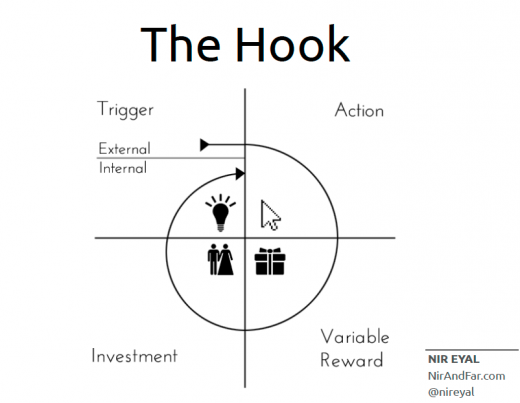Behavior and technology have a tenuous relationship with one another; however, one has always tried to inform the other. Hooked by Nir Eyal presents an interesting approach to how understanding habit formation (and behavior in general) can be helpful in reaching business-oriented goals for all professional levels; not only will this approach aid in increasing executive productivity, it will help make employees more productive on all levels. The simple truth is that majority of observable human behavior is primarily an instance of behavior elicited by an antecedent, and then rewarded (or punished). This behavioral relationship, when reinforced over time, becomes a habit. Sounds modest enough. Eyal’s explanation is elegant and easy to understand, centered around four events:
-
Trigger Behavior
-
Perform Action
-
Variable Reward for Action
-
Commitment to Product

Eyal manages to be both simple and accurate, and still only come in at a little over two hundred pages. It is in the unified and consistent approach to this behavior methodology and how it forms a habit where his content really shines. It should come as no surprise that the behavior model itself harkens back to an operant model of conditioning, but this in no way diminishes Eyal’s approach. His addition is commitment, which is the holy grail for behavior psychologists, as program adherence is difficult to maintain.
Eyal sees this fourth step as an answer to a nebulous question.
Let’s walk through his process. A potential customer is alerted to your service or product by a trigger; the behavior proceeds in short order. This feels firmly rooted in the antecedent-behavior relationship. Then comes the most important part: rewarding the behavior. Behavior psychologists (and enthusiasts like myself) always err on the side of intermittent schedules of reinforcements, which is a fancy way of saying you don’t always get the reward, but it is offered frequently enough that the reward is constantly being chased. It is the variability in the reward that gives it real value, as it demonstrates both engagement and authenticity in the process, which then feeds future instances––and on and on it goes.
Habit formation is the key to both delegation in the workplace and business growth strategies. Learning what behavior relationships are not well formed allows you to free up time accordingly by having an assistant step in with a well-designed process for accomplishing those troublesome behaviors. Eyal offers both a time-saving technique, but also a more nuanced approach to nurturing leads and client relationships in general. The true strong suit of the book is its accessibility, making it a wonderful portal into applied behavior analysis for business. It is truly a well-written resource that both offers useful, actionable information and a contemplative experience for everyday readers on behavior engineering. If you haven’t read it yet, we highly recommend that you do.
